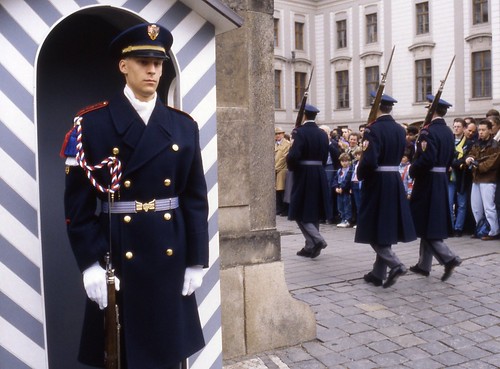When I visited in 1993, Czechoslovakia had only recent split into two countries: Slovakia and the Czech Republic. Prague is the historical capitol of Bohemia. It is capitol of the Czech Republic and its largest city. Situated on the Vltava River, it is home to about 1.4 million people; a couple hundred thousand more than when I visited over 30 years ago.
The Charles Bridge is one of the city's most iconic landmarks. It is a medieval stone bridge first constructed in 1158. At one time it was the only bridge that crossed the Vltavia River; now there are many. There was usually a lot of activity on the bridge. Sadly, when Mom visited, the bridge was quiet. Only pedestrians.
Charles Bridge
Across the Charles Bridge is the Prague Castle (complex or district). Prague Castle was built in the 9th century. It has long served as the seat of power for kings of Bohemia, Holy Roman emperors, and presidents of Czechoslovakia. According to the Guinness Book of Records, Prague Castle is the largest ancient castle in the world. We were fortunate to see the Changing of the Guard at the castle during one of our visits.
Golden Lane is a street situated in Prague Castle. Originally built in the 16th century to house Rudolf II's castle guards, it takes its name from the goldsmiths that lived there in the 17th century. Golden Lane consists of small houses, painted in bright colors. Most of the houses were souvenir shops. The last residents moved out in 1953.
Another thing Prague is known for is its clock. The Prague astronomical clock is a medieval astronomical clock attached to the Old Town Hall. The clock was first installed in 1410, making it the third-oldest astronomical clock in the world and the oldest clock still in operation. The Astronomical clock show runs every hour sharp from 9 am until 11 pm. I have seen the show several times.
On one of our visits, we saw a tribute to Prague Spring. Prague Spring was a period of political liberalization in Czechoslovakia that lasted for about 7 months in 1968. The Soviet Union and other Warsaw Pact member invaded Czechoslovakia to end the reforms. The US did nothing.
Tribute to "Prague Spring"
There is an old Jewish cemetery in Prague. It was founded in the first half of the 15th century. It is among the oldest surviving Jewish burial grounds in the world. What's noteworthy about the cemetery is that bodies were buried on top of each other, with graves layered up to 10 deep. While the cemetery was expanded several times, it was never big enough to meet the needs of the Jewish town. There are about 12,000 tombstones in the cemetery. It was unlike any cemetery I had ever seen.
One of the things I remember most about Prague is the marionettes. There were so many of them. Shops selling them. Street entertainment. Czech marionettes have been a part of Czech tradition since the middle of the 18th century, when Czech puppeteers roamed Central Europe to entertain crowds and tell stories. I bought marionettes for my niece and nephew and one for myself. Years later, I bought big sheep and goat marionettes. Sometimes I used them for teaching. Everyone loves them. I love puppetry. My favorite scene in the Sound of Music is the "Lonely Goat Herd."











No comments:
Post a Comment